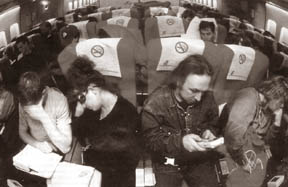|
observer |
|
|
|
|
|
OTHER LINKS |

|

|

|
From AbroadFlight socks to counter DVTWearing elasticated 'flight socks' significantly cuts the risk of DVT, a major study has shown. Airline passengers who wear compression stockings have one tenth of the risk of developing deep vein thrombosis (formation of blood clots) (DVT) on longhaul flights compared to those who do not, scientists found. DVT occurs when blood flow is restricted and clots form, usually in the legs. It can prove fatal if a clot breaks off and reaches the lungs. The condition hit the headlines after several healthymen and women died after long flights. Most DVT cases, however, occur in hospital patients who spend long periods lying in bed, unable to move. To counter the problem, doctors recommend wearing stockings that apply pressure to the lower leg to encourage blood flow.
The same principle was used in the design of 'flight socks', which were made specifically for those embarking on long-haul flights. Experts reviewed all the available evidence to see if the stockings really do reduce the risk of DVT among air passengers. This involved the analysis of nine studies which covered 2,800 passengers on flights of seven hours or more. Of the 50 who developed symptomless DVT, 47 were not wearing stockings. There were major differences between the trials, however. In three of them, no one developed DVT, regardless of whether they wore the stockings. By pooling together the data and taking into account different factors from the trials such as age and susceptibility (vulnerability) to disease, the researchers concluded that the overall risk of getting DVT for those who wore the stockings was one tenth of that of passengers who did not. The findings were published in the Cochrane Library Journal. Lead researcher Professor Mike Clarke, of the UK Cochrane Centre in Oxford, said: "This review shows that airline passengers travelling for long distances can expect a substantial reduction in the incidence of symptomless DVT if they wear compression stockings." Studies suggest the chance of getting DVT is about one in every 6,000 long-haul journey for a healthy person. Last December, a Government report warned that all forms of transport involving a journey of four hours or more increased the risk of DVT. But the Department for Transport also said the condition was far more common among those in hospital than among those who travel. Experts say the risk of DVT is higher in over 40s who have a family history of blood clots, have recently had surgery or have existing circulation problem. Symptoms include swelling, pain and redness, especially on the back of the leg, which may even develop during a journey. These can also occur hours or even days later. In some cases, there are no obvious symptoms and problems become obvious only when a pulmonary embolism (obstruction of lungs) occurs, causing breathlessness, chest pain and, in severe cases, death. Doctors warned that those who spend all day at their desk could fall victim to a new type of DVT, 'e-thrombosis'. Dr. Beverly Hunt, a blood specialist at Guys and St. Thomas' hospitals in London, said she was seeing the condition in patients who sat at a desk all day, then went home and sat in front of a computer all evening. She warned that any long journeys, not just air travel, could also bring on the condition. "It can happen whenever you're cramped into a small space and can't move your legs, which could be a bus, a train or a car," she added. Experts advise passengers to clench their calf muscles while sitting, and regularly stand up and stretch their legs on long journeys to avoid getting DVT. |









